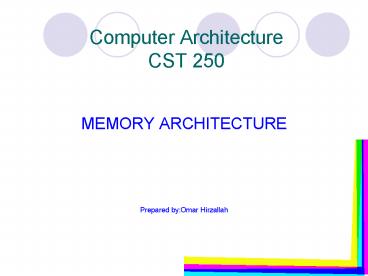Computer Architecture CST 250 - PowerPoint PPT Presentation
Title:
Computer Architecture CST 250
Description:
Computer Architecture CST 250 MEMORY ARCHITECTURE Prepared by:Omar Hirzallah Contents CPU & Main Memory Architecture RAM & Types Comparison CMOS ROM ... – PowerPoint PPT presentation
Number of Views:84
Avg rating:3.0/5.0
Title: Computer Architecture CST 250
1
Computer ArchitectureCST 250
- MEMORY ARCHITECTURE
- Prepared byOmar Hirzallah
2
Contents
- CPU Main Memory Architecture
- RAM Types
- Comparison
- CMOS
- ROM Types
3
CPU Main Memory Architecture (Von Neuman)
Data Bus
Input / Output
Processor
ROM
RAM
C.U.
A.L.U.
Address Bus
Control Bus
4
RAM
- RAM RWM.
- Random Access Memory, it means,
- to access the memory location in the entire
memory is very easy and fast. - RAM is used for temporary storage of program and
data. - It is volatile so it will lose the data if the
power is turned off. - You can W/R from it with equal ease.
5
Comparison of DRAM SRAM
DRAM SRAM
Data will be lost as the power shuts down, or capacitor loses its charge. Data will be lost as the circuits get powered down.
It needs refreshing from time to time to keep its contents. Refreshing, not required.
It is composed of Capacitors Transistors. It is composed of transistors and resistors.
Slower than SRAM. Faster than DRAM as no refreshing is required.
It takes less space on a chip as compared to SRAM memory cell. It has more parts so SRAM cell takes more place on chip then DRAM cell.
Cheaper than SRAM. Expansive than DRAM.
It is used for Main Memory. It is used for Cache Memory.
6
Types of DRAM
- 1. SDRAM Synchronous DRAM
- It is a type of DRAM that can run at much
higher clock speeds than conventional memory. - SDRAM actually synchronizes itself with the CPU's
bus and is capable of running at 133 MHz, - About twice as fast EDO DRAM.
- SDRAM is replacing EDO DRAM in many newer
computers - SDRAM usually comes in DIMM packaging, which
itself comes in several different formats
(buffered and un-buffered, 3.3 volts and 5
volts).
7
- 2. DDR Double Data Rate SDRAM
- DDR SDRAM is similar in function to regular
SDRAM, but doubles the bandwidth of the memory by
transferring data twice per cycle--on both the
rising and falling edges of the clock signal.
- 3. RDRAM Direct Rambus DRAM
- a high-speed 16-bit bus running at a clock rate
of 400 MHz - As with DDR SDRAM, transfers are accomplished on
the rising and falling edges of the clock,
yielding an effective theoretical bandwidth of
approximately 1.6
G.bytes/second (DRAM) - Used with Intel PIII and P4.
8
CMOS complementary metal oxide semiconductor
- CMOS chips require less power than chips using
just one type of transistor. This makes them
particularly attractive for use in
battery-powered devices, such as portable
computers. Personal computers also contain a
small amount of battery-powered CMOS memory to
hold the date, time, and system setup parameters.
9
ROM ITS Types
ROM ? (READ ONLY MEMORY) It is an integrated
circuit that is programmed with specific
instructions at the time of its manufacturing. It
is also known as FIRMWARE. Firmware means that
its a hardware component along with built in
software stored on it.
1 PROM ? Programmable Read Only Memory It has a
special device for its burning named PROM
Programmer, but It can be burned only once.
2 EPROM ? Erasable Programmable Read Only
Memory It can be erased by using Ultra violet
light rays.
3 FLASH MEMORY OR EEPROM ? Electronically
Erasable Programmable Read Only Memory It can be
erased electronically for burning again, e.g.
BIOS, CMOS etc.
BIOS stands for BASIC INPUT OUTPUT SYSTEMS































